The 10 Best Climbing Shoes of 2021, Tested by an Expert

Unless you’re Charles Albert, there’s no piece of gear more important to a climber than climbing shoes. Even free soloists like the world-famous Alex Honnold, notorious for using no protective gear at all, will bring rock shoes (and sometimes chalk) up the wall with them. At the bare minimum, every climber needs at least one pair of the best climbing shoes in their arsenal if they want to perform well on their project.
That said, just as with any other type of workout shoe, performance isn’t the only factor to consider. When shopping for climbing shoes, you also have to take into account comfort, durability, versatility and price of the shoes, among other factors. “For newer climbers buying their first pair of shoes, I’d recommend a shoe that’s reasonably priced and comfortable,” says professional climber and trad crusher Molly Mitchell, one of only a handful of women in the world to have sent 5.14 trad. “It doesn’t have to be too aggressive, although maybe you’ll take them off between routes just for saving them,” she adds.
More from Footwear News
Zegna Is the Latest Luxury Brand to Launch an Outdoor Collection
How 9 Runners Are Using Their Platforms to Tackle Today's Most Pressing Challenges for Women
For starters, let’s break down the different types of climbing, because each requires a different focus. Then, we’ll dive into some of the techniques and subsequent performance factors you need to consider when buying your shoe, before providing a list of the 10 best climbing shoes in 2021 — backed by this writer’s own testing as well as expertise from Mitchell and professional boulderer Drew Ruana. (Bonus: These also make great gifts for the outdoorsman in your life.)
Types of Climbing
Indoor Climbing: Nowadays, most beginners learn to climb indoors inside climbing gyms. The best indoor climbing shoes put a focus on comfort and performance. The rubber on your shoes isn’t going to wear out on plastic as fast as it will on rock, so durability is less important in this case. You also won’t be needing to wear these shoes for long periods of time (most gym walls don’t go above 50 or 60 feet), so you want a shoe that you can put on and take off quickly when it’s your turn to climb or belay. For this reason, I never recommend lace-up shoes as beginner indoor climbing shoes.
Sport Climbing: Sport climbing is all about performance and, along with bouldering, it’s where most beginner climbers get their first experience on real rock. The best sport climbing shoes will vary in style, depending on how strong of a climber you are and the type of sport routes you like to climb (overhung, face, slab, etc.). But most likely, you’ll want to focus on solid smearing, toeing, edging and hooking.
You aren’t going to be jamming, and like indoor shoes, sport shoes don’t need to be left on all day. You’ll be taking them off and on frequently as you and your partner swap burns, so most climbers look for an aggressive, downturned shoe that prioritizes performance.
Bouldering: Bouldering and sport climbing both typically call for aggressive shoes. Even more so than sport climbing shoes, however, bouldering shoes are extremely performance-focused, with a spotlight on hooking, pockets and steep terrain. These are shoes you’ll likely only be wearing for a few minutes at a time, just to power out under a dozen tough-as-nails moves — so you want them to be powerful, putting your feet in the best position possible to send your project.
Trad Climbing: If you’re looking for a trad shoe, you’re probably already an experienced climber, and much of the information here is irrelevant to you. That said, trad shoes put focus on comfort, durability and support, in addition to performance. Particularly if you’ll be doing any multipitch climbing (and you probably will if you climb trad), you’ll be wearing these shoes for long, long days.
You want a shoe with a flat, neutral footbed and a thicker outer. This helps it stand up to wear and tear from the rocks and provides reliable support when jamming in cracks. Most trad shoes are also higher-topped, and burlier overall, to protect your feet and ankles from abrasion.
Common Foot Techniques in Climbing
Edging: Edging is probably the most common climbing technique. Any time you’re using the toe, the outer (and occasionally the inner) rim of your climbing shoe to stand on small holds, you’re edging. Edging is what you’ll be doing 90% of the time when you’re climbing in a gym.
Smearing: Smearing is another common technique, involving “smearing” your foot on a blank face, using the friction between your shoe and the rock to power yourself upwards. It’s less effective indoors on plywood gym walls but can offer surprisingly good support on friction-heavy rocks like granite. Smear power is particularly important when slab climbing and on many face routes.
Hooking: Hooking can come from either the toe or the heel. It’s an advanced technique where you place your heel (or toe) onto a hold and then pull in towards your core, using the opposing pressure to either balance and rest for a moment or pull yourself upwards. This technique is commonly used when climbing arêtes, near a ledge or on overhung terrain.
Jamming: Jamming is an advanced technique involving both hands and feet and is used for crack climbing. Jamming is perhaps the most difficult of all climbing techniques to learn, at least when it comes to jamming with your hands. In the case of foot jams, jamming consists of placing your foot into a crack sideways, then twisting to turn your foot vertically again, using the opposing forces on either side to “jam” your foot into the crack and provide a faux-foothold that you can push off of.
Get the scoop on top shoe and sneaker shopping guides with Footwear News’ Weekly Style newsletter.
The 10 Best Climbing Shoes in 2021
Evolv Defy
Best Beginner Shoe for Indoor Climbing
The Evolv Defy was the rock shoe I bought when I first started rock climbing nearly fifteen years ago. I went through three pairs of Defys before upgrading to a different shoe, and I still recommend them to all my friends getting into the sport. They’re neutral and comfortable, offering an all-day-long fit and break in quite fast. All told, they’re one of the best beginner climbing shoes.
Unlike many other newbie shoes, they’re also sensitive, with decent edging and particularly solid heel hooking. The flip side of that sensitivity is that these shoes wear out quite fast, but they’ll hold up fine if you’re planning on primarily climbing indoors (as most beginner climbers do, at least for a while). Add that to the sub-$90 price point, which hasn’t changed since I was a gumby over a decade ago, and you have a standout starter shoe that won’t break the bank.
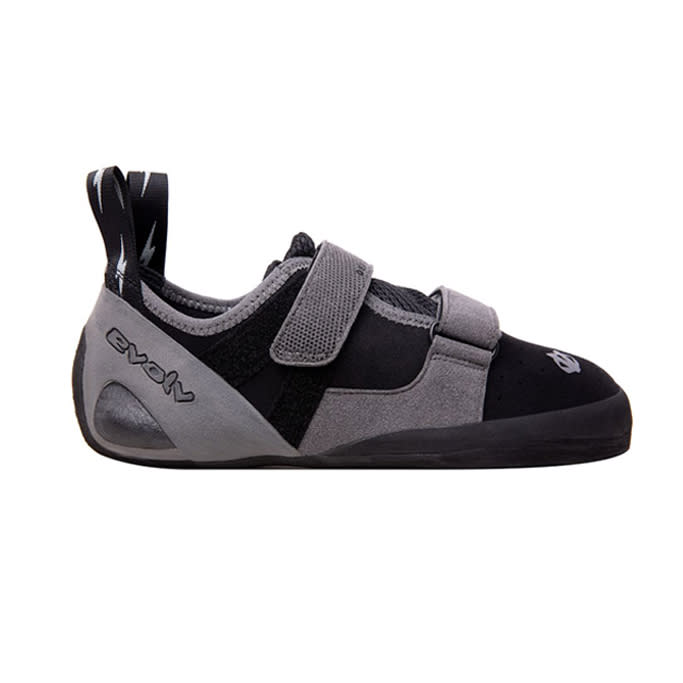
Courtesy of Backcountry
La Sportiva Tarantulace
Best Beginner Shoe for Outdoor Climbing
Like the Defy, the La Sportiva Tarantulace is an excellent budget option for beginners. It sits at a comparable price point and offers a similar level of comfort and neutrality. With 5 millimeters of rubber, however, it’s a fair bit thicker than the average rock shoe (including the Defy, which is 4.2 millimeters). This means increased durability, but decreased sensitivity. Pick your poison.
If you’re a beginner that is spending a lot of time outside, the Tarantulace is likely a better pick. It’ll hold up longer on real rock than the Defy, is a bit stiffer for added comfort and one of the best climbing shoes for slab and even cracks as a beginner. However, you’re not going to see the same level of sensitive performance as the Defy. The lace-up style used here is my personal favorite, since it allows you to fine-tune your fit, but keep in mind that it means these shoes take longer to put on and take off than a velcro shoe like the Defy or a slipper. This is another reason why these are better shoes for outdoor climbers than indoor ones.
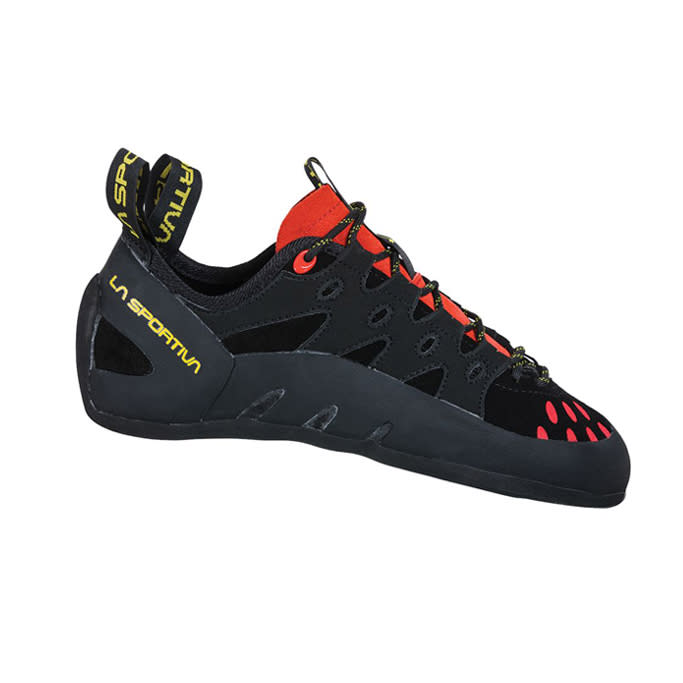
Courtesy of Backcountry
Buy:
La Sportiva Men's Tarantulace
$85
Buy:
La Sportiva Women's Tarantulace
$85
Five Ten Hiangle
Best Climbing Shoe for Women
Almost all of the shoes on this list are either unisex or have both female and male variants, but the female version of Adidas/Five Ten’s Hiangle rock shoe is a stellar choice for women in particular. The aggressive downturn allows you to lock in on the smallest edges, and the full rubber heel provides maximum friction for all sorts of hooks. The microfiber upper is among the more breathable and comfortable uppers in high-performance shoes as well.
“I love the Hiangles,” said Molly Mitchell. “I wear them for pretty much everything, because they are stiff but I can still feel my toes on holds. It’s the perfect combo of an aggressive and comfortable shoe.” Mitchell notes that the Hiangles are especially good for women with narrow heels, like herself.
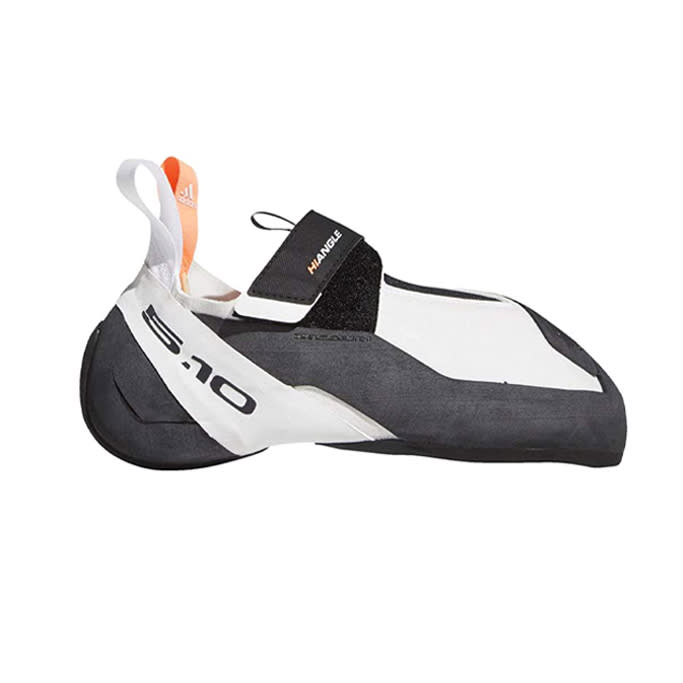
Courtesy of Amazon
Tenaya Iati
Best Outdoor Bouldering Shoe
Professional climber Drew Ruana is of the top outdoor boulderers in the United States, with nearly a dozen V15 and V16 sends under his belt and almost twice that many V14s. He put the high-performance velcro Tenaya Iatis at the #1 slot in his arsenal this season, which says something. “As primarily an outdoor climber, the Iatis’ hard midsole makes it easier to hone in on small footholds, and the heel rand feels like cheating,” he says.
“Although not the most aggressive shoe I’ve worn, the stiffness and slight downturn work wonders on almost all outdoor boulders, making the smallest footholds feel locked in,” Ruana adds. “The glued-on rand on the heel catches nicely on precise heel hooks, and while I don’t notice it as much inside, the shoes’ performance outside makes me feel much more confident in my feet.” The Iatis shoes aren’t cheap — they’ll run you close to $200 — but for a technical, aggressive boulder shoe, they’re a choice pick.

Courtesy of Amazon
Black Diamond Aspect
Best Trad Climbing Shoe
Birthed by none other than Yvon Chouinard, the famous American climber and environmentalist who went on to found Patagonia, Black Diamond has been making top-quality climbing gear for decades. However, the brand only recently moved into the climbing shoe space with a handful of shoes that have been surprisingly well-received.
The Aspect is their first trad shoe, with a stiff, neutral sole that works equally well when edging and jamming in cracks, and is a solid shoe if you’re looking for comfort during big days on the wall. The downsides are that its performance is significantly dampened on steeper terrain, and the low-top design offers less protection than most trad-specific shoes for gnarlier crack lines (but also prevents Achilles pain on long days). All told, it remains an excellent shoe for traditional and big-wall climbing at an affordable price.
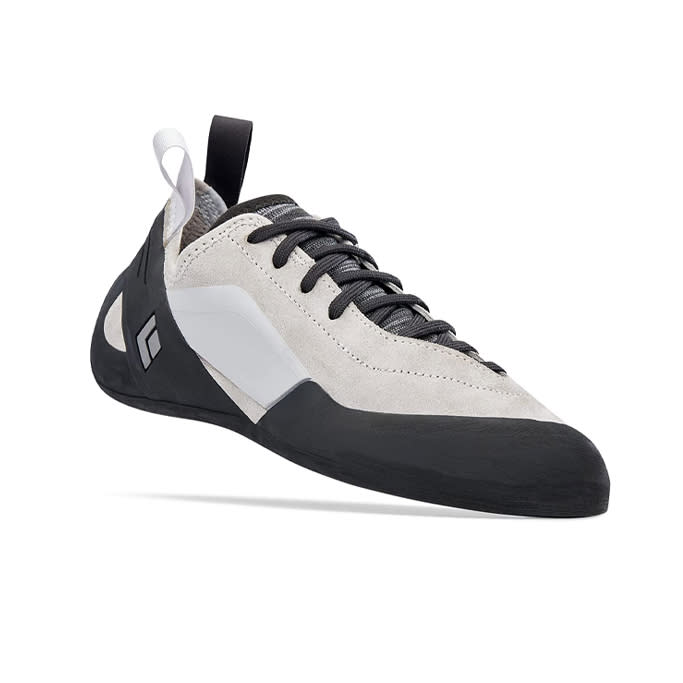
Courtesy of REI
Buy:
Black Diamond Aspect
$108-$275
Five Ten Men’s Moccasym
Best Crack Climbing Shoe
Both the Aspects (above) and the TC Pros (below) are stellar crack shoes, and arguably higher performance crack shoes all-around. That said, Adidas/Five Ten’s Moccasyms come at an astoundingly low price point that catapults them above the competition as the best crack climbing shoes around, in this author’s opinion, at least for crack novices.
What I mean by that is they’re a top-notch choice if you’re just getting into crack climbing and looking to buy a crack-specific auxiliary shoe without breaking the bank. In addition, they also excel indoors, and the slip-on style makes them great for quick on-and-off belay swaps at the gym (slippers are also my personal favorite for crack routes). The full leather upper is undoubtedly one of the most comfortable-fitting slipper uppers out there, and the triple slings — one on the top of the foot and two on the heel — allow you to pull these puppies on and off in a split second. There’s also a new men’s Niad model with added tech, though it’s a bit pricier.

Courtesy of Amazon
Buy:
Five Ten Men's Moccasym
$29-$184
Scarpa Instinct SR
Best Climbing Slipper
If you’re looking for a slipper that can still go toe-to-toe with the best velcro shoes on the market, the Scarpa Instinct SR is your buy. It also comes in lace-up and velcro iterations, but the slipper version stands out as one of (if not the) highest performing slippers available on the market. The easy-on, easy-off shoe is designed with bouldering in mind, particularly indoor cave routes.
It’s one of the most comfortable downturned slippers out there, with a reinforced elastic band that stretches well for easy on and off but sucks in on your foot for a sensitive, aggressive fit. With only 3.5 millimeters of rubber on the outer, this shoe is far from the most durable climbing shoe. That said, on any indoor or outdoor short line, the Instinct will more than hold its own if performance is a top priority.
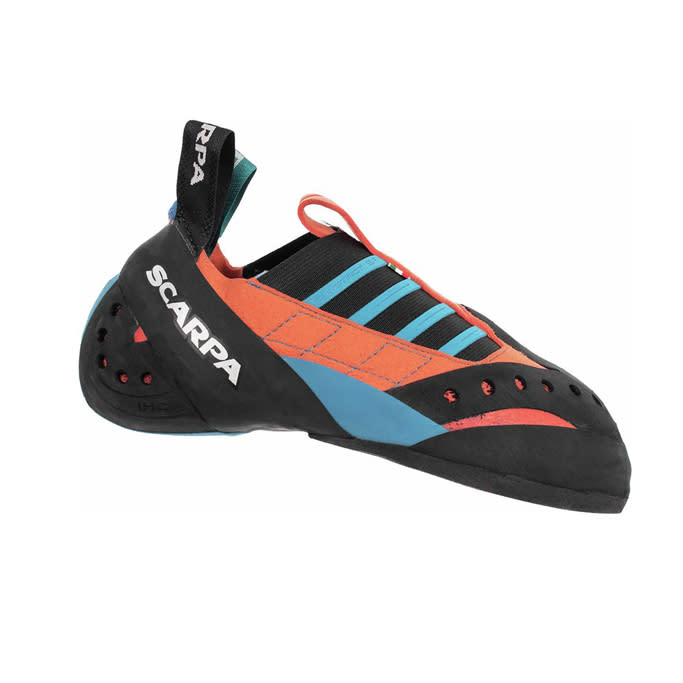
Courtesy of Backcountry
Buy:
Scarpa Instinct SR$168
$126
La Sportiva Solution
Best All-Around Performance Climbing Shoe
La Sportiva is perhaps the best-known climbing shoe brand, particularly when it comes to aggressive shoes, and the Solutions are their most popular shoes for nearly a decade now. If you’ve watched Alex Honnold or Adam Ondra in action, chances are you’ve seen Solutions on their feet.
The shoes feature an aggressive downturn that is a powerhouse on steep single-pitch and bouldering, with a unique velcro system that offers perhaps the best “locked-in” fit of any velcro shoe on the market. The thick heel is one point of contention among many users — it’s a love-hate thing — but all told, this is one of the most highly-rated shoes in climbing shoe history. They aren’t cheap, but for hard boulders and steep sport routes, most climbers would say you can’t do better than a pair of Solutions. So even if you’re hesitant, it’s worth giving them a try.
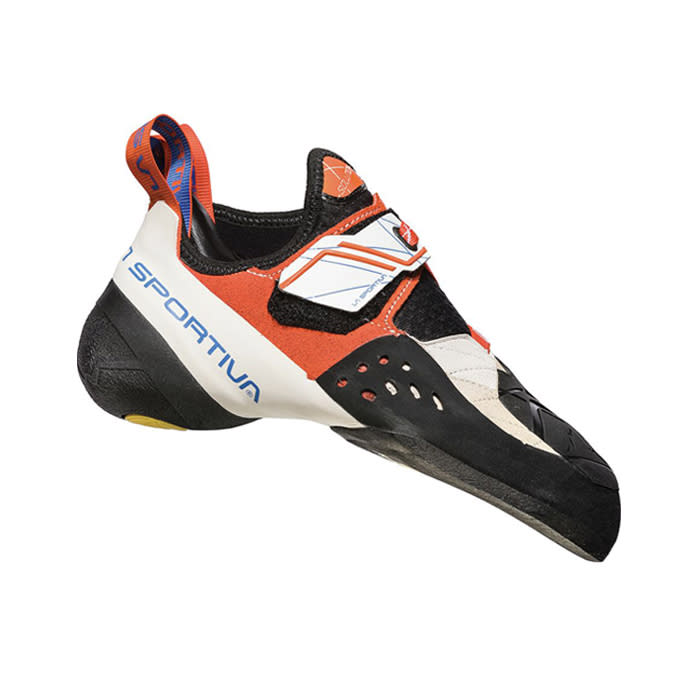
Courtesy of Backcountry
Buy:
La Sportiva Men's Solution
$180
Buy:
La Sportiva Women's Solution
$180
La Sportiva TC Pro
Best Big Wall Climbing Shoe
Ever seen “Free Solo?” (Haven’t we all, at this point? There was a solid year or two there where you couldn’t step into a climbing gym without hearing someone talking about it.) In any case, Honnold soloed El Cap wearing TC Pros. Enough said.
These shoes hit the sweet spot between high-powered performance and all-day comfort, making them arguably the best big-wall shoes in existence, and they’re getting an upgrade this year — so they’re better than ever. You’ll find incredible edging, high-top ankle protection for rugged cracks and a supportive sole that keeps your feet in the game for long multipitch days. Where these shoes fall short is on steep terrain, or on sensitivity-focused high-end gym, sport or boulder routes. They’re about 33% more expensive than the Black Diamond Aspects (above), which are comparable shoes, but the performance increase is worth the extra cash, particularly if you have a big wall on the menu.
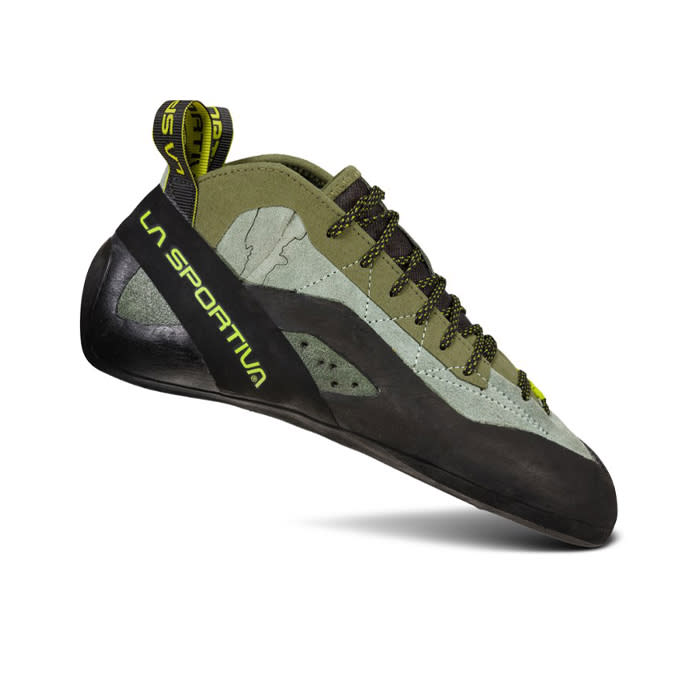
Courtesy of REI
Evolv Shaman
Best Climbing Shoes for Wide Feet
As someone with wide feet and small fiber neuropathy (a brutal combination for a climber), most uber-aggressive lines of shoes, like the La Sportiva Solutions, have never worked well for me despite their high performance. To tell it straight, my feet start to hurt like hell after awhile. For folks like me, the Evolv Shaman is a great alternative aggressive shoe. It still excels on steep terrain and hard boulders but doesn’t skimp on comfort.
Designed by one of the most legendary climbers of the ’90s and 2000s, Chris Sharma, the Shaman is famous for its “love bump” — which pushes your toes forward into an aggressive pose and keeps the shoe downturned throughout its life. That feature, and the Shaman’s comfortable midsole, help your feet stay primed to crush without the jammed-up pain often associated with aggressive rock shoes. The Shamans are particularly good at locking into pockets and are one of the best shoes for steep climbing, but they still manage to put some focus on comfort (which is much appreciated by climbers like myself). Many climbers find they fall short on edging, due to their soft rubber, but I’ve always been a fan.

Best of Footwear News
Sign up for FN's Newsletter. For the latest news, follow us on Facebook, Twitter, and Instagram.


